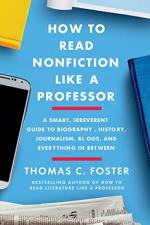
|
| Name: _________________________ | Period: ___________________ |
This test consists of 5 short answer questions, 10 short essay questions, and 1 (of 3) essay topics.
Short Answer Questions
1. In Chapter 15, "Reading Internet Sources," what does Foster call the "fatal flaw" of the internet?
2. In Chapter 15, "Reading Internet Sources," what does Foster say leads to better thinking?
3. In Chapter 13, "On the Stump," Foster refers to White House staff as "denizens" (190). What is the best definition of this word in this context?
4. In Chapter 15, "Reading Internet Sources," what does Foster say the contemporary world lacks?
5. In Chapter 14, "The Universe of Ideas/Ideas of the Universe," what are two reasons Foster points to for disbelief in science?
Short Essay Questions
1. In Chapter 10, "From the Inside Out," why does Foster say that the process newspapers follow to assure balanced treatment in opinion pieces creates a false dichotomy?
2. In Chapter 13, "On the Stump," what are the three categories that Foster says outsider exposés fall into, and why does he say that they are more reliable than insider's writings?
3. In Chapter 9, "Living the News," why does Foster say that Hunter S. Thomson's Fear and Loathing in Las Vegas is really a roman à clef?
4. In Chapter 13, "On the Stump," what concern does Foster say that other journalists have about Wolff's work?
5. In Chapter 15, "Reading Internet Sources," Foster reveals the central issue of the book. What does he say the issue is, and why does he believe it is worth devoting a book to?
6. In Chapter 15, "Reading Internet Sources," what does Foster propose as a solution to inaccuracies on the web?
7. In Chapter 15, "Reading Internet Sources," what does Foster say is problematic about the internet and web?
8. In Chapter 12, "That Is So Last Year," what difference does Foster explain between primary and secondary sources?
9. In Chapter 9, "Living the News," what two main types of subjective nonfiction does Foster define, and what four categories does he break these main types into?
10. Explain why, in Chapter 11, "Life from the Inside," Foster says that the narrators of nonfiction can be just as unreliable as the narrators of fiction.
Essay Topics
Write an essay for ONE of the following topics:
Essay Topic 1
Based on the language and tone of Foster's book, who is his imagined audience? Is this audience consistent throughout the book? Give specific textual examples as you analyze how Foster's language and tone reveal the presumed audience for this book.
Essay Topic 2
In Chapter 9, "Living the News," Foster discusses the work of Joan Didion. Write an essay in which you describe his tone in this discussion of Didion and then analyze how he creates this tone.
Essay Topic 3
Write a comparison and contrast essay in which you explain how reading nonfiction is both similar and dissimilar to reading fiction.
|
This section contains 896 words (approx. 3 pages at 300 words per page) |

|




